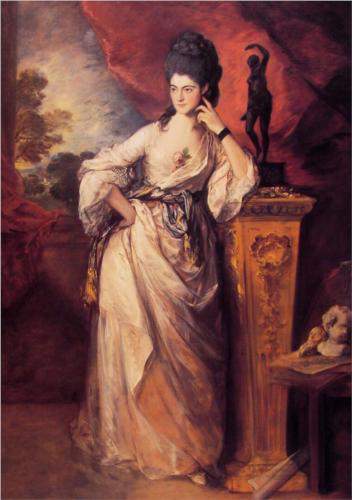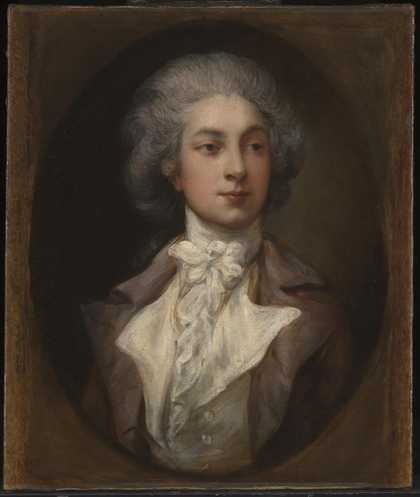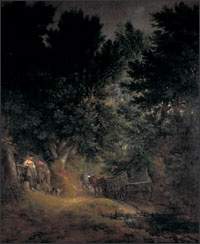
Lady Ligonier by Thomas Gainsborough, 1771, oil on canvas, 236x 155 cm
Lord Pitt commissioned Gainsborough's twin portraits of his daughter and her husband, an avowedly brainless army officer. Doubtless the artist could see all too well what became evident in a scandal that broke as the pictures were being exhibited - while Lord Ligonier was besotted with horses, his wife had a preference for grooms. Hence, perhaps, her pose leaning against a plinth bearing a statuette of a d
Thomas Gainsborough’s name conjures up ladies in gauzes and satin – the epitome of 18th-century elegance and sensibility. The sheer sensuous appeal of pictures such as Lady Ligonier – painted in the early 1770s, when the artist was at the height of his career as a fashionable portrait painter – might make one think that there is little else to him. But in fact there is very much more. He stands together with his older contemporary William Hogarth as among the first British painters to gain an international reputation, and whose achievements still have resonances today.
It is easy enough to see what Hogarth initiated, with his challenging and overt social commentary. He invented a new kind of narrative cycle, in which he described the foibles of his age with a Swiftian bite – as in his account of a foolish young rake going to rack and ruin. This was a modern art charting an entrepreneurial commercial society that was new in the 18th century, but which has subsequently become the norm throughout the Western world. Hogarth’s work inspired, among other things, the brilliant political cartoons of Gillray and the moralising modern life painting of the Pre-Raphaelites. More recently it proved a resource for the tongue-in-cheek treatment of contemporary commercialism by British Pop artists such as David Hockney. There is more than a hint of Hogarthian darkness, too, in the unsettling world of Damien Hirst. But what of Gainsborough? What has he got for us beyond a whiff of the ancien re gime?
Perhaps the most evident innovation he had to offer was a new freedom in handling paint. The tendency can be seen among other British artists of the period, but none took it as far as Gainsborough did. It comes out most fully in his wonderful spontaneous studies and in unfinished work such as the late mythological subject, Diana and Actaeon. It always has a presence, however, in his mature works. Criticised in some quarters for the ‘roughness’ of his work, Gainsborough defended it as a sign of his special powers. His rival Sir Joshua Reynolds, president of the Royal Academy, spoke of the ‘odd scratches and marks’ on Gainsborough’s canvasses; but even he marvelled at how ‘this chaos, this uncouth and shapeless appearance, by a kind of magick [sic], at a certain distance assumes form.’
Later critics, notably Roger Fry, saw the foreshadowing of Impressionism in this painterly flow. It might also seem to anticipate abstraction. It is no accident that one of Gainsborough’s greatest admirers was the American artist James McNeill Whistler, that pioneer of ‘Art for Art’s sake’. Whistler emulated Gainsborough’s painterly elegance in his own portraits. He even adopted many of his predecessor’s methods, including the use of lengthy brushes and exceptionally liquid paint to achieve effects at once daring and refined.
Yet concern for effect never replaced observation for Gainsborough. Trained in London in the 1740s, when Hogarth was at the height of his fame, he adopted that artist’s habit of sharp observation, insisting that likeness should remain the principle aim of a portrait. This was not simply to demonstrate mimetic skills. It was in order to grasp mood and personality. He was noted for his accuracy in capturing that subtle play of expression known as ‘countenance’. When he left London to set up a practice in his native Suffolk he sometimes used this skill to devastating effect in depicting the local gentry. His masterpiece of this period, Mr. and Mrs. Andrews, shows a smart young couple in front of the land that was the source of their affluence. The smug superiority in their glances can’t be bettered. Gainsborough had known both sitters since childhood – though as a social inferior, the son of a bankrupt. Perhaps he was paying them back.
He could also observe tenderly, as in the well-known painting of his two young daughters chasing a butterfly. Equally moving is the later portrait of his wife. By this time he was running a leading London practice. While he basked in fame she retired, somewhat neglected, into the shadows. We can see a wistful resignation in her face. But there is also a sense of her husband’s concern for her – even a hint of remorse. Like most great portraits, this one is the outcome of a genuine interchange between sitter and artist.
Despite his success, Gainsborough claimed portraiture was a chore. His first love was landscape. The lively view in Mr. and Mrs. Andrews shows he could record places every bit as well as people. Yet there was little call for such work at the time. Later in life he produced grander, more generalised scenes, such as The Market Cart. These Arcadian images based on the English countryside were key in encouraging artists to explore their native land. While valuable for providing access to the sentiments of the 18th century, such works are less to our taste now than the innovations of Turner, Constable and the other great landscapists who followed him. In the best of his portraits, however, he has no peer.
Gainsborough’s reputation as a portraitist did not stand him in good stead among avant-garde Modernists in the 20th century. Artists aspiring to achieve ‘pure form’ thought portraiture too compromised by its need to represent, and its habitual dependence on the interests of a client. Yet throughout this period the practice had powerful supporters in Britain. Francis Bacon, in particular, showed how there need be no conflict between modernity and figure painting. His tortured depiction of individuals seem light years away from the elegant world of Gainsborough.
However, Bacon shared with Gainsborough the concern to balance invention with observation. ‘One of the reasons why I don’t like abstract painting, or why it doesn’t interest me,’ he commented, ‘is that I think painting is a duality, and that abstract painting is an entirely aesthetic thing.’ When Bacon talked, in relation to a Rembrandt self-portrait, of ‘a coagulation of non-representational marks which have led to the making of this very great image’, he almost seems to be echoing Reynolds’s observations on Gainsborough.
This interest in painting as a duality has encouraged subsequent generations to reconsider portraiture. It is hardly surprising to find Pop artists – those revivers of the figurative – in the forefront of the rediscovery. When David Hockney turned to portraiture, after his early years as the wunderkind of British Pop art, he explored the lives of the rich and famous with a wry wit that echoed the art of the 18th century. A great admirer of Hogarth, he had already modelled a satirical narrative of his first visit to New York on the latter’s Rake’s Progress. In his portraits he seems closer to the nuances of Gainsborough. His Mr. and Mrs. Clark and Percy is as arch as Gainsborough’s Mr. and Mrs. Andrews. It draws deliberately on the tradition of grand portraiture while subtly undermining it. As Hockney himself remarked, he has inverted traditional relationships by having the woman standing while the man is sitting. Hockney knew the couple closely, had been the best man at their wedding. His picture deliberately brings out tensions in what was acknowledged to be an ‘unconventional’ marriage. Both pictures use a combination of shrewdly observed expression and masterful placement to highlight unease.
This is a reminder of how ‘modern’ Gainsborough was in his approach to portraiture, setting observation above convention. His attentiveness brought him close at times to the psychological complexities that have been evident in much contemporary portraiture. One might not think of Lucian Freud, the master of such work, as having any point in common with Gainsborough. Yet at times they can be within hailing distance of each other. As has been seen in the late portrait of his wife, Gainsborough is at his most touching when painting close friends and members of his family. He records them clearly, with all their frailties, while engaging the ties of affection. The questioning exploration of intimacy and vulnerability is a strain that gives weight to Freud’s work. His moving portraits of his mother in her last years share something of the mood that Gainsborough intimates in his most personal work. Gainsborough, like Freud, is a painter of experience. It is this that makes his work still live for us today.
William Vaughan is Pevsner Professor of History of Art at Birkbeck College, University of London. His book Gainsborough was published earlier this year by Thames & Hudson at 8.95.
About the artist
Born 1727 in Sudbury, Suffolk, the son of a cloth merchant who went bankrupt. Sent to London to work for an engraver at 13; opened his own studio at 17; married at 19. Spent 1750s in Suffolk and 1760s in Bath, where he established himself as a fashionable portrait painter. Founder-member of the Royal Academy in 1768; moved back to London in 1774. Squabbled with RA and held annual exhibition at Schomberg House, his home in Pall Mall. In later years he specialised in ‘fancy pictures’, idealised portraits of pretty, well-fed beggar children, which are too sentimental for today’s tastes. Died 1788, London; buried in Kew churchyard.


